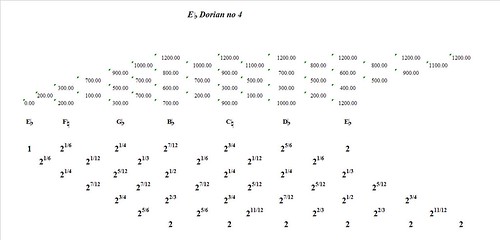
The E Flat Mixolydian no 4, diminished 5 mapped to the Square-root-of-2 Scale. With 6 notes spread out over 600 cents - with just one quarter-tone - this scale poses an interesting cognitive challenge. Square-root-of-2 based scales already pose the challenge of treating the 600-cent so-called "tritone" as a pitch class equivalent. Which is difficult to convey sonically since the "double tritone" is the familiar 1200-cent octave that is hard-wired in the human auditory system as strongly equivalent. In practice, the 1200-cent interval will always seem more "equivalent" than the 600-cent or even 1800-cent interval. So this particular scale will sound like a standard chromatic scale with two quarter-tones as this 6-tone sequence repeats at each tritone. The conceptual challenge is to compositionally treat 600-cent intervals as pitch class equivalents and allow the subtle contour of the single quarter-tone to emerge from within the harmonic fabric.











